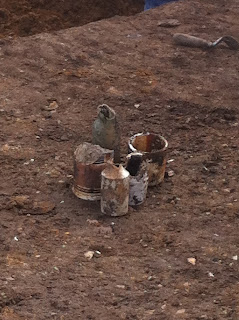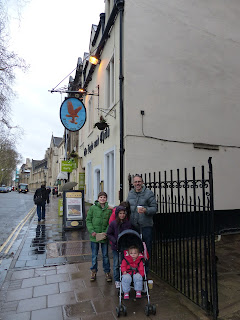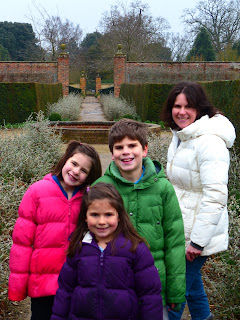On Tuesday we went to the Botanical Gardens. We went to look at some frog-spawn to check if they had hatched.
Mum decided that we should learn about frogs and do a life cycle about frogs.
Here is my life cycle.
It says:
1. The English common frog hibernates in winter. The frogs start in October and end in January then the frogspawn are born.
2. When the frogs are born they hatch and turn into tadpoles. Tadpoles are the early stage of frogs.
3. The tadpole has it hind legs grown before its front legs.
4. The tadpole then grows their front legs. They are then at the start of being a frog.
5. The frog loses its tail. It is then a froglet.
6. The froglets then turn into adult frogs.
The house we are staying in, has a life cycle kit of a frog and butterfly. I put the life cycle of a frog together as well:
Tuesday 26 March 2013
Anglesey Abbey
On Saturday we went to Anglesey Abbey. At Anglesey Abbey I won two awards.
On was at Lode Mill and the other at Lord Fairburn's house.
I won the one at Lode Mill because I spun a small version of a grinding stone 6 times.
I won the other medal at Lord Fairhaven's house because I completed a quiz.
Lord Fairhaven's house had a lot of very expensive things. He had too many of them a bit too many horses. He had a lot of collections. He collected silver and gold horses, statues, clocks and art.
We aso walked through the gardens and saw this pheasant.

On was at Lode Mill and the other at Lord Fairburn's house.
I won the one at Lode Mill because I spun a small version of a grinding stone 6 times.
I won the other medal at Lord Fairhaven's house because I completed a quiz.
Lord Fairhaven's house had a lot of very expensive things. He had too many of them a bit too many horses. He had a lot of collections. He collected silver and gold horses, statues, clocks and art.
We aso walked through the gardens and saw this pheasant.

Friday 22 March 2013
My archaeology visit
Today I went with Jacob and dad to an archaeological dig. It was a dig where they were hoping to find Roman ruins.
At the archaeological dig we learned how the Celts would make a wooden house and how archaeologists know where to dig.
This is how the Celts would make a house:
She took us to the the dig site and we saw the remains of a Celtic house. It was three different coloured soils and one of the colours was orangeish yellow. Another was orange. The last one was grey.
We saw a road that was heading right into the house. We figured out it was a Roman road. The Celtic house came before the Roman road.
There was also an area which they thought was a Victoran rubbish dump. They were finding broken glass, pots, Marmalade jars. We made her fish up an old bottle that was used for soda or beer or other drinks.
We also got to feel different parts of Roman pottery. We then had to do a sheet about an object they had found.
We also found lots of potatoes!
At the archaeological dig we learned how the Celts would make a wooden house and how archaeologists know where to dig.
This is how the Celts would make a house:
- First they put post holes in the ground.
- They put wood in the post holes.
- They make a roof.
She took us to the the dig site and we saw the remains of a Celtic house. It was three different coloured soils and one of the colours was orangeish yellow. Another was orange. The last one was grey.
We saw a road that was heading right into the house. We figured out it was a Roman road. The Celtic house came before the Roman road.
There was also an area which they thought was a Victoran rubbish dump. They were finding broken glass, pots, Marmalade jars. We made her fish up an old bottle that was used for soda or beer or other drinks.
We also got to feel different parts of Roman pottery. We then had to do a sheet about an object they had found.
We also found lots of potatoes!
Thursday 21 March 2013
Bath
We went to visit Bath last week.
On the way there we saw Salisbury Cathedral. It was really big and it had one of the biggest spires in Britain.
We also visited Old Sarum. It's an old ruined castle. It used to be an iron age fort.
Then we saw Stonehenge (which means 'hanging stones'). Fact: the stone in the middle of Stonehenge with the lump on it was made to hold a stone up. Each month the sun shines through a different one of the little holes.
The next day we spent in Bath. First we went to the Roman baths. They were where Roman people would have baths and swims together.
Then we went to the Pump room. That's a place where in Jane Austen times and before, people would hang out and have food and drinks. It was a bit like a cafe. We had 'Bath buns' there.
After that we went to the Fashion Museum. At the Fashion museum we drew dresses and a I did a sticker trail. I also dressed up like a Victorian. It was my favourite thing I did. It was educational and fun.
Next we went to the Jane Austen centre. It was a place where we learned about Jane Austen. I learned that she never married - she was engaged for 24 hours once, but that was it.
Then we went to Bath Abbey. It was really fun. We also did a quiz. The quiz was really educational.
On our last day we went to some cute villages. One had a nice little stream and lots of bridges.
After that we went to Oxford. First we went to C.S. Lewis' house (Clive Staples Lewis). C.S. Lewis wrote the Narnia series.
Then we went to his church.
Then we went to J.R.R. Tolkien's house. (J.R.R. Tolkien wrote the Lord Of The Rings).
Next, we went to the Eagle and Child (where J.R.R. Tolkien and C.S. Lewis met sometimes).
Our last stop was the Martyrs' memorial.
On the way there we saw Salisbury Cathedral. It was really big and it had one of the biggest spires in Britain.
We also visited Old Sarum. It's an old ruined castle. It used to be an iron age fort.
Then we saw Stonehenge (which means 'hanging stones'). Fact: the stone in the middle of Stonehenge with the lump on it was made to hold a stone up. Each month the sun shines through a different one of the little holes.
The next day we spent in Bath. First we went to the Roman baths. They were where Roman people would have baths and swims together.
Then we went to the Pump room. That's a place where in Jane Austen times and before, people would hang out and have food and drinks. It was a bit like a cafe. We had 'Bath buns' there.
After that we went to the Fashion Museum. At the Fashion museum we drew dresses and a I did a sticker trail. I also dressed up like a Victorian. It was my favourite thing I did. It was educational and fun.
Next we went to the Jane Austen centre. It was a place where we learned about Jane Austen. I learned that she never married - she was engaged for 24 hours once, but that was it.
Then we went to Bath Abbey. It was really fun. We also did a quiz. The quiz was really educational.
On our last day we went to some cute villages. One had a nice little stream and lots of bridges.
After that we went to Oxford. First we went to C.S. Lewis' house (Clive Staples Lewis). C.S. Lewis wrote the Narnia series.
Then we went to his church.
Then we went to J.R.R. Tolkien's house. (J.R.R. Tolkien wrote the Lord Of The Rings).
Next, we went to the Eagle and Child (where J.R.R. Tolkien and C.S. Lewis met sometimes).
Our last stop was the Martyrs' memorial.
Tuesday 12 March 2013
It's snowing
On Monday it was snowing and mummy told us to look closely at the snow. She told us that we should do snow poems about what the snow was like.
Here is my poem. I hope you like it!
It's Snowing
The snow is falling fast outside
And I am cosy inside.
The snow is going round and round.
And I am swiftly on the ground.
It gracefully makes friends with me.
It turns like stars with dainty marks.
they flutter to our local park.
It turns and spins. And then it wins.
It flies through wind like little pins.
It smiles and then it turns away
and then it goes on holiday
Here is my poem. I hope you like it!
It's Snowing
The snow is falling fast outside
And I am cosy inside.
The snow is going round and round.
And I am swiftly on the ground.
It gracefully makes friends with me.
It turns like stars with dainty marks.
they flutter to our local park.
It turns and spins. And then it wins.
It flies through wind like little pins.
It smiles and then it turns away
and then it goes on holiday
The Lion, the witch and the wardrobe
I've just finished reading The Lion, the Witch and the Wardrobe, by CS Lewis. The main characters are Edmund, Lucy, Susan and Peter, the white witch, Aslan and the beavers.
In the book, Lucy goes in a wardrobe. When she comes out they don't believe anything she says. The next time, Edmund follows her and finds Lucy inside. When Lucy comes out she tries to tell Susan and Peter again but Edmund lies. The next time they all go in and that is where the adventure starts! Edmund is lost and they try to get him back. The beavers tell them about the White witch and Aslan. They decide to look for Aslan to help get him back. The White witch loses and is not queen anymore (she really isn't, she just says it ). Lucy, Edmund, Peter and Susan do end up being kings and queens anyway.
My favourite part was when the white witch lost. What I didn't like was when Edmund was captured. What I did like was when they got Edmund back.
My favourite character is Susan. The reason why I chose Susan is because she is brave and beautiful. Susan is brave because she sometimes fights. The reason I know she is beautiful is because Lucy wants to be as beautiful as Susan.
In the book, Lucy goes in a wardrobe. When she comes out they don't believe anything she says. The next time, Edmund follows her and finds Lucy inside. When Lucy comes out she tries to tell Susan and Peter again but Edmund lies. The next time they all go in and that is where the adventure starts! Edmund is lost and they try to get him back. The beavers tell them about the White witch and Aslan. They decide to look for Aslan to help get him back. The White witch loses and is not queen anymore (she really isn't, she just says it ). Lucy, Edmund, Peter and Susan do end up being kings and queens anyway.
My favourite part was when the white witch lost. What I didn't like was when Edmund was captured. What I did like was when they got Edmund back.
My favourite character is Susan. The reason why I chose Susan is because she is brave and beautiful. Susan is brave because she sometimes fights. The reason I know she is beautiful is because Lucy wants to be as beautiful as Susan.
Monday 11 March 2013
Wimpole Hall
On Saturday we went to Wimpole Hall.
We saw lots of animals on the farm there:
We went to the garden. It reminded us of The Secret Garden:
Then we went to the hall. We did quizzes at the house. There was one really posh one and the servants one. I did the posh one. I learned that:
We saw lots of animals on the farm there:
Shetland pony
a kid
Pigs trying to drink milk - they ended up pushing their mummy down!
Highland cow
Lambs that have just been born! They are still wet.
We went to the garden. It reminded us of The Secret Garden:
- there were seven drawers in some chests of drawers. The reason why is because there is seven days in the week and there is one drawer for each of them.
- the stairs have different railings. The posh one had a wooden railing because it will last longer and feels smoother. The servants have a metal one which isn't as nice.
- the stairs are wide and shallow. The wide ones are the posh ones. They do that so two people can go down at a time beside each other and because they look like they are gliding down the stairs and look more elegant!
Wednesday 6 March 2013
Towns
We've been learning about the Middle Ages this week. I've been finding out what towns were like back then.
Most of the cities were really small. London was the biggest city of all of them.
They usually threw their rubbish out the window which made flies and rats come. It also made it very stinky.
They also did a lot of trading such as foods, clothes and much, much more.
Fires used to be even more dangerous than now. The reason why they were even more dangerous than now is because they shops and the houses were really close together. The fires could also fill up most of the place.
The towns also had brick walls around them.
Here is a map of Cambridge drawn just after the Middle Ages.
photo from wikipedia commons.
Most of the cities were really small. London was the biggest city of all of them.
They usually threw their rubbish out the window which made flies and rats come. It also made it very stinky.
They also did a lot of trading such as foods, clothes and much, much more.
Fires used to be even more dangerous than now. The reason why they were even more dangerous than now is because they shops and the houses were really close together. The fires could also fill up most of the place.
The towns also had brick walls around them.
Here is a map of Cambridge drawn just after the Middle Ages.
photo from wikipedia commons.
Monday 4 March 2013
A day at a castle and a burial place
On Saturday we went to Framlingham Castle. Framlingham Castle is a Norman castle. We went up to the top. Here are some photos:
We also went to Sutton Hoo. When I was doing my journal I made up some jokes about the name. One of the jokes went like this:
A: Knock knock
B: Who's there?
A: Sutton
B: Sutton who?
A: Just say the name! :-(
Another goes like this:
Jacob: We're going to Sutton Hoo.
Elsie: Eh? I didn't quite get that.
Jacob: We're going to Sutton Hoo.
Elsie: Sutton who??
Jacob: Yeah, that's it.
Elsie: That was a question!
Jacob: No that who!
There we saw Edith Pretty's house.
We also saw the Anglo-Saxon burial mounds, which were just grass.
What I liked best about Sutton Hoo was going to Edith Pretty's house. She was the woman who was living there in the 1930s and decided that she should ask someone to dig up the burial mounds and see what was in them. They discovered a king and some amazing treasures.
Subscribe to:
Posts (Atom)











































